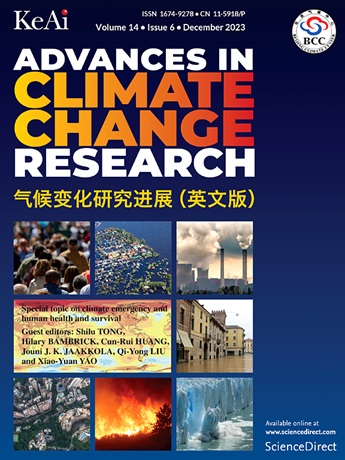Interplay between snow phenology and vegetation phenology in Alaska under climate change
IF 5.2
1区 地球科学
Q1 ENVIRONMENTAL SCIENCES
引用次数: 0
Abstract
Snow cover is one of the most important factors controlling Arctic ecosystems' microclimate and plant growth conditions in Arctic ecosystems. Climate change has impacted the timing and spatial variability of both snow cover, and worldwide vegetation phenology across the globe. However, the mechanisms by which snowpack factors regulate the onset of the growing season remain to be thoroughly investigated, particularly under varying climatic conditions and growth stages. In this study, we investigated the influence of snow characteristics on vegetation phenology across different growth stages. Specifically, we analyzed the spatiotemporal dynamics of vegetation and snow phenology in Alaska from 2001 to 2021, assessed the partial correlations between key phenological groups under controlled temperature and precipitation conditions, and quantified the contributions of climatic variables and snow cover to vegetation phenology across various growth-cycle phases. The results revealed that grassland and forest phenology responded strongly to variations in snowmelt timing (r > 0.5, p < 0.05). In contrast, although phenological responses in wetlands were also statistically significant (p < 0.05), the average correlation was weaker (mean r ≈ 0.45). Temperature was found to be the primary driver of vegetation phenology change during the peak growth periods, whereas snow temperature and depth were crucial drivers during the transitional growth phases. From 2001 to 2021, the changes in vegetation phenology in Alaska were more pronounced than those in snow dynamics. Notwithstanding the significant role of other co-varying drivers of vegetation-phenological shifts, the influence of snow phenology was crucial. This study elucidates the role of snowpack phenology in regulating vegetation dynamics under changing climatic conditions and growth cycles.
气候变化下阿拉斯加积雪物候与植被物候的相互作用
积雪是控制北极生态系统小气候和植物生长条件的重要因素之一。气候变化影响了全球积雪和植被物候的时空变化。然而,积雪因子调节生长季节开始的机制仍有待深入研究,特别是在不同的气候条件和生长阶段下。在本研究中,我们研究了不同生长阶段积雪特征对植被物候的影响。本文分析了2001 - 2021年阿拉斯加州植被和雪物候的时空动态,评估了在温度和降水控制条件下关键物候类群之间的部分相关性,并量化了不同生长周期阶段气候变量和积雪对植被物候的贡献。结果表明,草地和森林物候对融雪时间的变化响应强烈(r >;0.5, p <;0.05)。相比之下,尽管湿地的物候响应也具有统计学意义(p <;0.05),平均相关性较弱(平均r≈0.45)。在生长高峰期,温度是植被物候变化的主要驱动因素,而在过渡生长阶段,积雪温度和积雪深度是植被物候变化的主要驱动因素。2001 - 2021年,阿拉斯加植被物候变化比积雪动态变化更为明显。尽管其他共变驱动因素在植被物候变化中发挥着重要作用,但雪物候的影响至关重要。本研究阐明了气候条件和生长周期变化下积雪物候对植被动态的调节作用。
本文章由计算机程序翻译,如有差异,请以英文原文为准。
求助全文
约1分钟内获得全文
求助全文
来源期刊

Advances in Climate Change Research
Earth and Planetary Sciences-Atmospheric Science
CiteScore
9.80
自引率
4.10%
发文量
424
审稿时长
107 days
期刊介绍:
Advances in Climate Change Research publishes scientific research and analyses on climate change and the interactions of climate change with society. This journal encompasses basic science and economic, social, and policy research, including studies on mitigation and adaptation to climate change.
Advances in Climate Change Research attempts to promote research in climate change and provide an impetus for the application of research achievements in numerous aspects, such as socioeconomic sustainable development, responses to the adaptation and mitigation of climate change, diplomatic negotiations of climate and environment policies, and the protection and exploitation of natural resources.
 求助内容:
求助内容: 应助结果提醒方式:
应助结果提醒方式:


